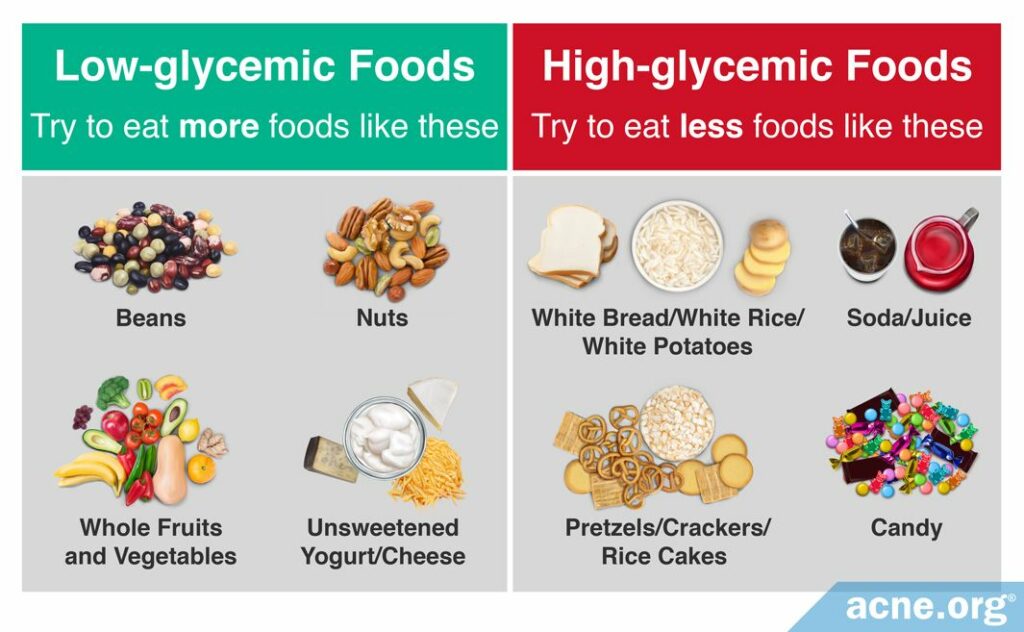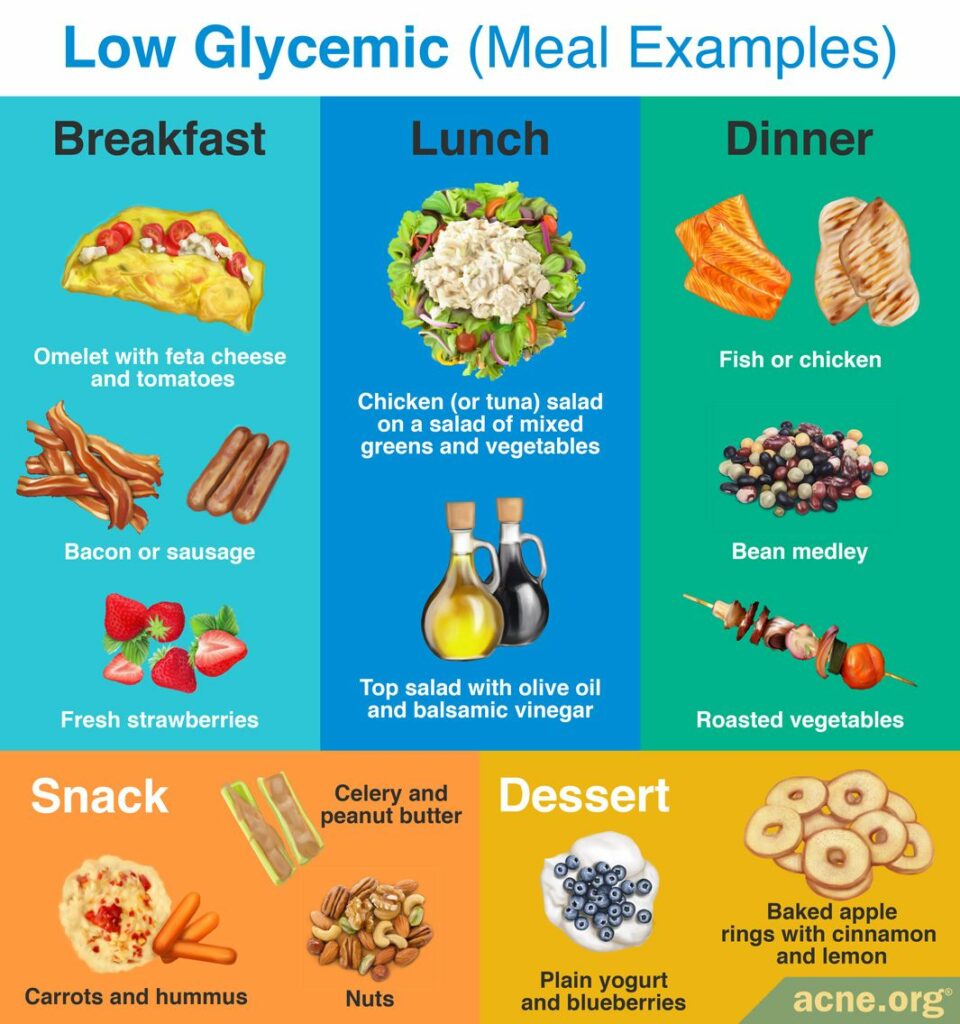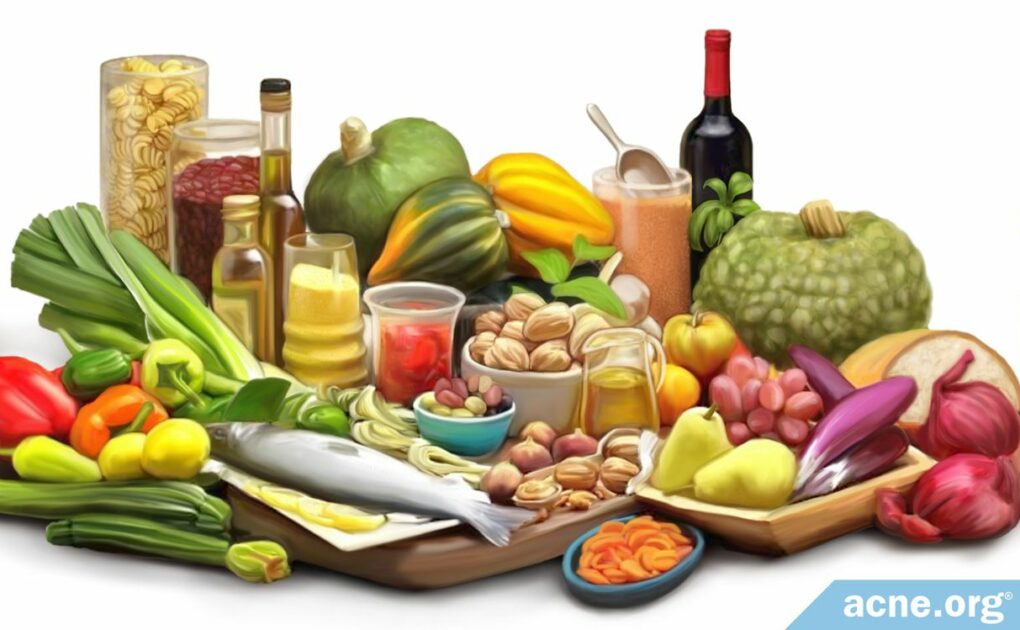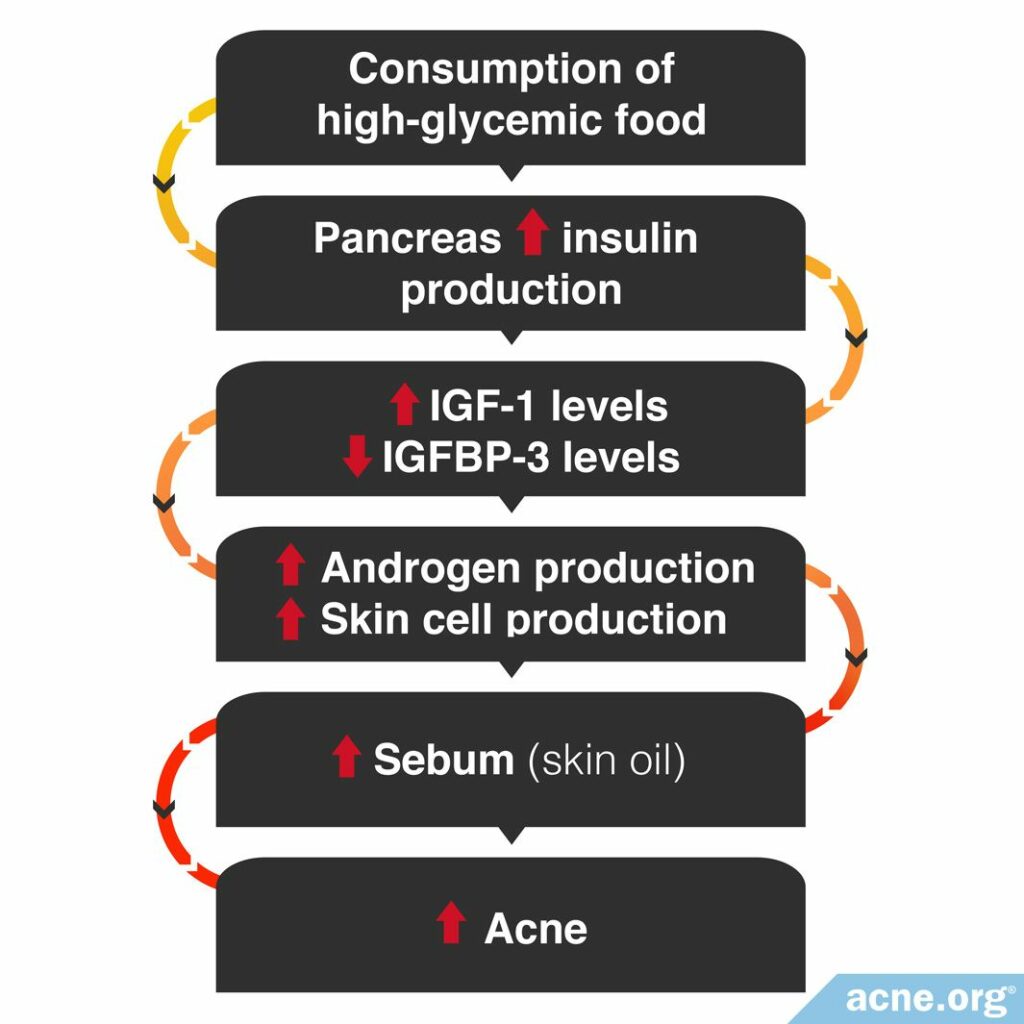Eat More Whole Fruits and Vegetables, Meats, Beans, & Nuts, and Eat Less White Bread, White Rice, Soda, Juice, Candy, & Processed Foods

The Essential Info
Studies have shown that a low-glycemic diet may help reduce acne.
To eat a low-glycemic diet:
Eat More: Unprocessed, low-sugar, whole foods like meat/poultry/fish, vegetables, whole fruits, nuts, beans, oil, and eggs
Eat Less: Processed, high-sugar foods like white bread, white rice, pretzels/crackers, candy, soda, and fruit juices

The Science
- Tips for Including Low-glycemic Foods in Your Diet
- Conclusion
Several scientific studies have recently shown that eating a low-glycemic diet, which includes foods that do not cause large increases in blood sugar levels, may help reduce acne symptoms.1-3 This article will explain what a low-glycemic diet entails and discuss tips for selecting foods that are low glycemic.
If you just want to get quick tips, scroll through and look for the red TIPS.
Low-glycemic foods
Low-glycemic foods are foods that do not cause a large increase in blood sugar, and include unprocessed, whole foods such as:
- Vegetables
- Whole fruits
- Nuts
- Beans
- Meat/Fish
- Eggs
- Oils
- Cheese
High-glycemic foods
High-glycemic foods are foods that cause a large increase in blood sugar, and often include processed foods such as:
- White bread
- White rice
- White potatoes
- Soda
- Juice
- Pretzels/Crackers/Rice cakes
- Candy
IMPORTANT NOTE: Just changing your diet will probably not completely clear up acne, but there is a possibility that it may help. Be realistic when attempting to eat lower glycemic. Look for some improvement–and keep in mind that this may be a small improvement.

Examples of Low-glycemic Meals and Snacks
TIP: Here are some examples of low-glycemic meals and snacks:
- Breakfast: Omelet with feta cheese and tomatoes, bacon or sausage, and a side of fresh strawberries
- Lunch: Chicken or tuna salad on top of a salad of mixed greens and vegetables, topped with olive oil and balsamic vinegar
- Dinner: Chicken breast or fish, bean medley, and roasted vegetables
- Snack: A handful of nuts, baby carrots with hummus, or celery with peanut butter
- Dessert: Baked apple rings topped with cinnamon and lemon, or plain Greek yogurt with fresh blueberries

Tips for Including Low-glycemic Foods in Your Diet
TIP: Pick foods like beef, pork, poultry, fish, eggs, avocados, green leafy vegetables, peppers, berries, plums, peaches, grapefruit, and cheese. These are great options for a low-glycemic diet because they cause only small increases in blood sugar levels, even when they are eaten in large amounts.
TIP: Eat small amounts of high-glycemic foods. You can still achieve a low-glycemic diet when you include small amounts of high-glycemic foods.
TIP: Consult a glycemic table to verify the glycemic index and glycemic load per serving. If you are not sure whether a food is low glycemic or high glycemic, search that food on a glycemic table to determine the food’s glycemic value.
TIP: Balance glycemia by combining foods. If you are eating a high-glycemic food like pasta, incorporate a low-glycemic food like meat sauce, which contains nutrients such as fats and proteins. This can help balance the meal’s glycemic effect.
TIP: Do not assume that one food will always be low glycemic or high glycemic. Imagine that you have two packages of plain sugar cookies made by two different companies. Even though these cookies may look and taste the same, one cookie could be lower glycemic than the other cookie. The same type of food can be low glycemic or high glycemic, depending on the food’s:
- Ingredients: For example, if one cookie is made with white wheat flour, it will be higher glycemic than a cookie made with coconut flour.5
- How it is prepared: For example, if you bake a sweet potato, it will be higher glycemic than if you boil that same sweet potato.
- Where it comes from: Foods that come from different countries are often dramatically different, even if they are sold under the same name. According to Powell et al., “Kellogg’s Special K breakfast cereal is a very different product in North America (Kellogg Canada Inc) than in Australia (Kellogg, Sydney, Australia), each of which has a different GI value.”5
When you are selecting foods for a diet to reduce acne, consider what ingredients are used, how each food is prepared, and where the food originates from so you can determine whether a food is low glycemic or high glycemic.
TIP: While we do have some evidence suggesting that low-glycemic diets help reduce acne, it is unlikely that changing your diet will resolve your acne. It is still important to consider proven treatments if you have acne.
What Else to Consider for a Healthy Diet
While the tips given in this article are helpful for learning how to eat low glycemic, there are many other factors to consider for a healthy diet.
TIP: The glycemic index does not provide information about important nutrients your body needs, such as fat, protein, fiber, and vitamins. As such, people should refer to the glycemic index in combination with eating colorful fruits and vegetables and high fiber foods.
TIP: In 2002, researchers published an international table of the glycemic index and glycemic load for almost 1300 different foods.5 To know the exact glycemic index or glycemic load of a certain food, please consult the table here.
Conclusion
Some studies have shown that there might be a relationship between the glycemic load of a diet and acne: a low-glycemic diet has been shown to improve acne in certain studies.
The general rule when eating a low-glycemic diet is to keep portions of processed, high glycemic index foods small and to instead eat unprocessed, whole foods that contain little or no carbohydrates, such as meat, poultry, fish, vegetables, fruit, beans, cheese, oils, or eggs.
To know the glycemic index or load of a particular food, consult this table for the exact value.

